
Planning a kitchen remodel usually brings a mix of excitement and stress, especially when it gets down to picking colors for the cabinets. Homeowners often expect this part to be easy, but the thousands of shades, finishes, and styles can leave anyone second guessing. Cabinet colors are one of the first things people notice when they walk into the room, so choosing the right ones matters more than we sometimes admit. The way a color interacts with light, flooring, counters and appliances can affect the entire flow of the room. This is why searching through kitchen cabinet color ideas can help you form clearer direction before spending money or time on paint and materials.
Many people also remodel because they want their home to feel more like their style, or they’re hoping to refresh old cabinets without replacing everything. Color has power here. A simple shift in tone can make the kitchen feel wider, warmer, brighter or calmer. Whether you prefer something muted or full of contrast, picking colors for cabinets is not just a design move, it’s also practical. The right choice can help hide fingerprints, boost resale appeal, and make everyday cooking feel more enjoyable. This guide walks you through what matters and how different ideas can change a space so you feel more certain in your final decision.
1. What homeowners should think about before selecting kitchen cabinet color ideas for a remodel
Before picking paint samples, keep in mind why you are remodeling in the first place. Some homeowners want a modern refresh while others want warmth or a more classic look. Your goal shapes the type of kitchen cabinet color ideas worth considering.
- If you are hoping to make your home more attractive for future buyers, sticking to softer tones gives you a safer path.
- If you’re upgrading for yourself, you may feel more comfortable trying richer or trendy colors.
Your daily routine also matters. Families with young kids may not want bright white doors because fingerprints show up quick. People who cook a lot might want colors that hide scuffs or shade changes from steam and heat.
Another thing to think about is how long you want the cabinets to last before repainting. Darker tones stay interesting for years, but they also show dust faster. Pale shades stay timeless but can feel flat if you do not pair them with the right hardware and lighting. Your personal taste influences this decision more than you might realize, so take time to think through what makes a kitchen comfortable for you. Some people love contrast, some prefer softness. Both can work with the right balance.
Budget plays a part too. Paint finishes have different prices, and some cabinet styles need extra prep or sanding. Colors with more pigments may cost slightly more but deliver better coverage. Your space should guide your choices. Open kitchens allow more flexible colors, while smaller ones may need brighter tones to feel bigger. When you consider style, lifestyle, maintenance, cost, and size together, your kitchen cabinet color ideas begin to narrow in a helpful way.
2. How kitchen cabinet color ideas affect style, mood and function in a remodeled kitchen
Cabinet colors have a way of shaping how a kitchen feels before anyone even notices the appliances or decor. A room with soft tones can feel peaceful and open, while richer colors build coziness or sophistication. When sorting through kitchen cabinet color ideas, give thought to the atmosphere you want people to feel when they walk into your home. Some shades encourage energy, others feel calm and slow paced. These reactions happen without us paying attention, which is why color matters more than people think.
Style plays a major role too. A kitchen that leans toward modern design works well with lower contrast and smooth finishes. Traditional spaces do well with warmer or slightly rustic tones. Transitional kitchens can mix both worlds. By picking the right cabinet colors, you shape the personality of the room. Even small changes like cooler undertones versus warmer ones influence how your kitchen reads visually. A cool toned cabinet pairs well with stainless steel while warmer tones match wood floors nicely.
Function is also linked to color. Dark cabinets can hide cooking stains but may make a small kitchen feel tighter. Lighter shades reflect light and enlarge the view but can require more cleaning. Texture finishes matter. Matte hides smudges, gloss reflects light, and satin sits somewhere in the middle. Light reflection can change how often you wipe surfaces. All of these considerations affect how your kitchen works for you throughout the day. When you understand how mood, style and function interact, your kitchen cabinet color ideas start to align with the way you want your home to feel.
3. How lighting shapes which kitchen cabinet color ideas work best in your kitchen
Lighting may be the most overlooked part of choosing cabinet colors. The same shade can look completely different in warm bulbs compared to cool bulbs. Natural light changes everything even more. Before finalizing any kitchen cabinet color ideas, pay close attention to how light moves across your kitchen at different times. Morning sun can make some colors glow with warmth while evening shadows may dull them. If your kitchen faces north, cool light may give colors a slight blue tint. South facing kitchens often look warmer because the sunlight is stronger.
Artificial lighting also plays a large role. LED strips under cabinets can brighten colors or shift them slightly. Recessed lighting creates soft pools of brightness that can make cabinets appear lighter near the top and deeper near the base. Pendant lights with gold or silver shades reflect color differently. Warm temperature bulbs bring out yellow and red undertones, while cooler bulbs highlight gray or blue undertones. These shifts are subtle but real enough to change how satisfied you are with your final choice.
You also want to consider how shadows fall. Deep corners or tall cabinets hide light, which can make darker colors feel heavier. If your kitchen has limited windows, bright cabinet colors might be more fitting. On the other hand, if you get abundant daylight, you have more room to play with deeper tones. The best approach is to test several colors at different hours. Light controls the mood of the kitchen, so making decisions with lighting in mind gives you a better chance of ending up with the cabinet color you really intended.
4. How to test or compare kitchen cabinet color ideas before deciding
One of the smartest things you can do is test your kitchen cabinet color ideas before painting. Lots of homeowners skip this step because they feel confident about their favorite color, but samples prevent regret later. Start by using larger sample boards rather than tiny strips. A bigger sample helps you see how the color behaves across a wider area. Tape the boards to several parts of the kitchen, especially where shadows fall and where natural light hits directly.
Another method is trying peel and stick samples. These stick to cabinet doors easily and look more accurate than printed strips. You can also paint the inside of a cabinet door if you have leftover doors or drawers sitting around. This gives you the closest view of how the paint will look on the actual wood or material. Comparing the colors next to your counters, backsplash, and flooring provides a sense of harmony or contrast right away.
Look at the samples during different hours. Colors look one way in the morning, another in afternoon light, and something else at night. Also take photos. Cameras often show undertones more clearly than the eye can catch in the moment. Share the photos with someone whose style you trust if you need a second opinion. Testing prevents wasted money and time, and it gives your eyes a chance to adjust. When you see how each shade behaves in your home, you feel far more prepared to pick the best option.
5. How to match kitchen cabinet color ideas with existing or planned countertops, floors and appliances
Your cabinets don’t exist alone, so matching them with your kitchen’s other surfaces should be part of your planning. Counters, floors and appliances can make a cabinet color look better or worse depending on how tones interact. When choosing kitchen cabinet color ideas, look for either harmony or contrast. Harmony makes the room feel connected. Contrast adds interest. Neither is wrong, but the rest of your home style will help you decide which approach fits you better.
For counters, pay attention to movement and pattern. Marble with strong veins looks nicer with cabinets that don’t compete for attention. Quartz patterns can highlight color families within the stone, making it easier to pick a shade that feels intentional. Granite often has more warmth, so cabinet colors with soft creamy undertones usually blend smoother.
Your flooring matters just as much. Wood floors with warm hues pair best with colors that share warmth. Cooler floors like gray tile connect better with cool toned cabinets. If you have patterned floors, choose cabinet colors that repeat one of the tones found in the pattern. Appliances also play a role. Stainless steel leans cool, while white appliances sit quietly in the background. Black appliances look strong and anchor darker cabinet choices.
Thinking about these surfaces together helps you imagine the kitchen as one space instead of separate parts. When everything complements each other, the room feels cleaner and more intentional. This makes your final choice more rewarding and boosts your confidence as you finalize your remodel.
6. Warm kitchen transformations using soft clay inspired cabinet shades
Clay toned cabinets often bring a warm, familiar feel to the kitchen. These colors work well for homeowners who want something a bit richer than beige but not too bold. Clay tones mix soft brown, terracotta and tan influences, giving the room a grounded appearance. These shades pair well with brass hardware or simple brushed nickel. Because clay colors lean warm, they complement natural materials nicely, including open shelving, subtle tile patterns or raw wood accents. Homeowners who want a comforting mood often feel drawn to this type of cabinet shade because it feels lived in without feeling old.

7. Choosing the right cabinet finishes to match deep charcoal accents
Charcoal can make a kitchen feel bold without going too dark. If you want to use charcoal accents in your remodel, the cabinet finish you choose can shift the entire mood. Matte finishes create a soft impression, while satin adds a faint glow. Gloss reflects more light and makes charcoal look crisp. Charcoal works well with warm browns, muted greens or pale gray counters. The finish choice decides whether your kitchen feels dramatic or more relaxed. This gives you flexibility depending on how strong you want the charcoal to appear.
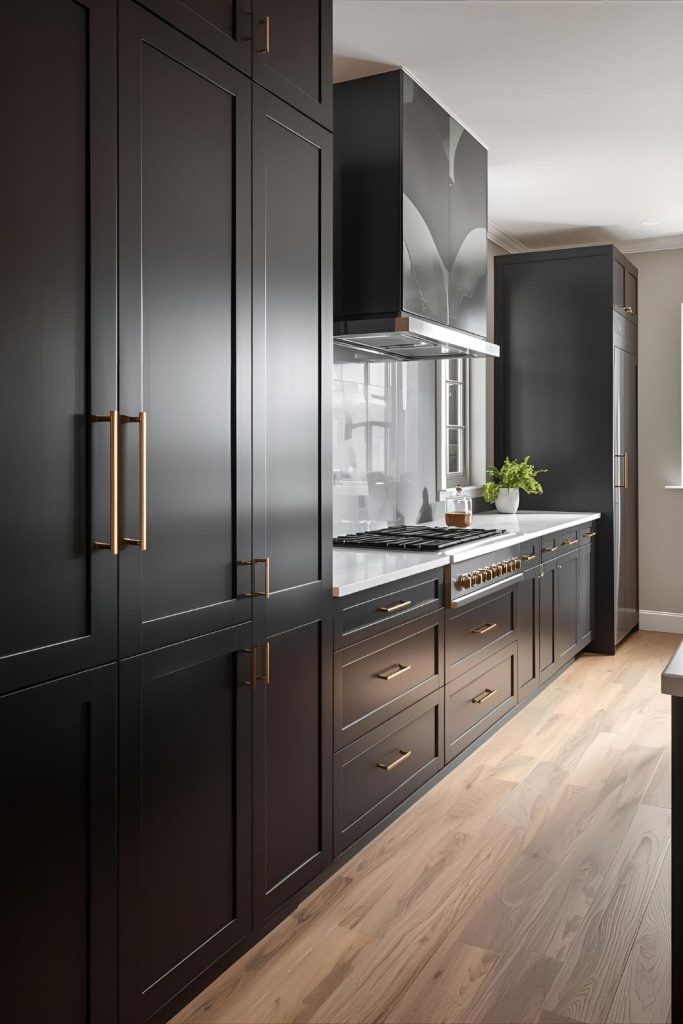
8. Exploring color pairings that bring out subtle coastal vibes
Coastal inspired cabinet colors often sit somewhere between soft blues, stone washed greens and pale grays. The goal is not to make the kitchen theme heavy, but to create a breezy, relaxed mood. Cabinet colors that pull from seafoam, misty sky tones or beach sand shades tend to make the space feel calm. Pairing these colors with white counters, light wood shelves, or silver hardware helps keep the room open and airy. Homeowners who love a clean but gentle palette usually find coastal color ideas reassuring and easy to maintain.

9. Fresh ideas for balancing strong colors with gentle neutrals
Balancing a bold cabinet color with softer neutrals can keep your remodel from feeling too intense. You could choose a deeper lower cabinet shade and pair it with lighter uppers. Another option is going bright on an island while keeping the rest neutral. This approach works with blue, green, brown or even yellow toned cabinetry. The neutrals soften the look while the richer color adds personality. This balance works especially well in kitchens that don’t get a lot of light because the neutral tones help open the room visually.

10. Elevating your remodel with rich dark espresso cabinetry
Dark espresso cabinets bring a steady, grounded look to the kitchen. They feel polished and go well with both classic and modern styling. Espresso pairs great with warm white counters, brushed gold hardware or off white walls. The color feels strong but not overly dramatic. If your kitchen has several windows or bright lighting, espresso cabinets maintain depth without making the room too heavy. Homeowners who want something that feels reliable and long lasting often gravitate toward espresso because it ages well and stays stylish.

11. How muted paint choices can soften an overly bright space
Muted paint colors can calm a kitchen that feels too sharp or bright, especially in homes with strong sunlight or lots of reflective surfaces. When you look through kitchen cabinet color ideas, soft grays, dusty greens and gentle taupes can bring steadiness to the room. These colors help mellow out the glare that comes from shiny tiles or stainless appliances. Muted tones work well for homeowners who want something quiet without losing personality. They give warmth without being too bold. They also work with both warm and cool counters, making them flexible for remodels where not everything is being changed. This approach is great if you prefer a relaxed kitchen that still feels intentional.
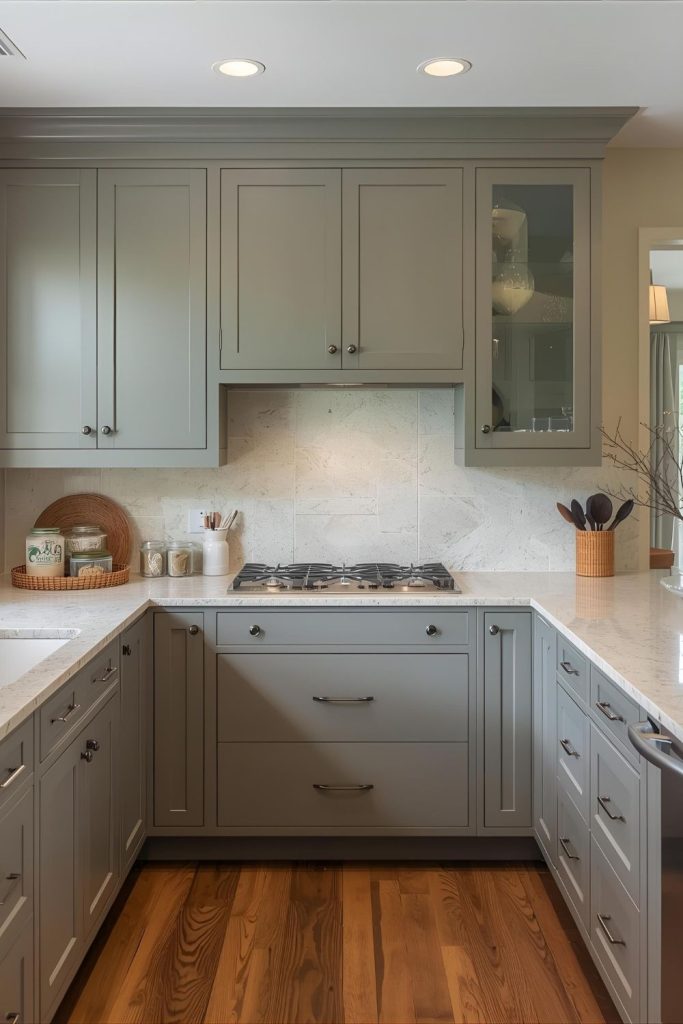
12. Brightening remodels using crisp white cabinetry as the anchor
Crisp white cabinets make a kitchen feel open even when the room isn’t very large. They reflect natural and artificial light, giving the space a comfortable glow. Many people check kitchen cabinet color ideas expecting white to be too plain, but it often becomes the smartest choice when the goal is brightness. White works with nearly any wall color, appliance finish or counter style. It gives you freedom to swap hardware, lighting or decor over time without repainting. White cabinets also create a sense of cleanliness, which is one reason they remain popular in remodels. They keep the kitchen feeling fresh even if other colors are darker.
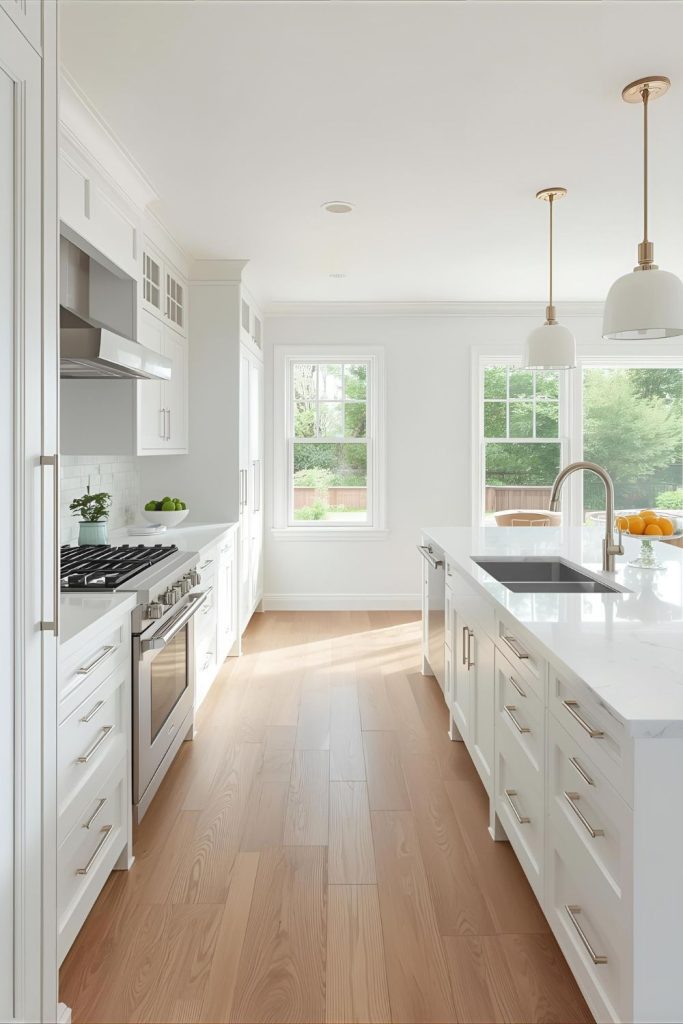
13. Adding character by blending natural wood finishes into your palette
Natural wood paired with painted cabinets brings warmth and charm into the kitchen without feeling busy. When reviewing kitchen cabinet color ideas, homeowners who want character often lean toward this mixed style. Wood grain carries its own pattern, so pairing it with soft greens, whites or clay tones helps balance the room. The mix works well with simple stone counters and matte hardware. It also feels grounded in homes with wood floors or exposed beams. The appeal comes from the natural texture, making the space feel inviting but not cluttered. This style is great for remodels where you want something visually interesting without overwhelming the space.

14. Refreshing your space using calming green undertones in the cabinetry
Green undertones can bring a peaceful, steady feeling to a kitchen. This shade works especially well for homeowners who want something more interesting than gray but not as bold as dark blue. Green sits comfortably between warm and cool, making it versatile with both brown toned floors and silver appliances. When searching for kitchen cabinet color ideas, many people choose sage, olive or misty green because these tones help soften the room and add a calm presence. Green also pairs nicely with gold hardware, stone counters and light flooring. It’s a reliable option for a kitchen that feels clean and welcoming.

15. Mixing farmhouse textures into softer cabinet color schemes
Farmhouse inspired touches like open shelving, textured wood, or simple metal hardware pair well with light cabinet shades. Soft whites, pale taupes and washed grays often show up in farmhouse kitchen cabinet color ideas because they help keep the room comfortable and warm. This style works well if you want your kitchen to feel homey without looking old. By keeping the cabinet colors subtle, the textures and natural materials stand out gently. This creates a lived in feel without clutter. Homeowners who appreciate a simple, relaxed look often find this mix easy to live with and maintain.
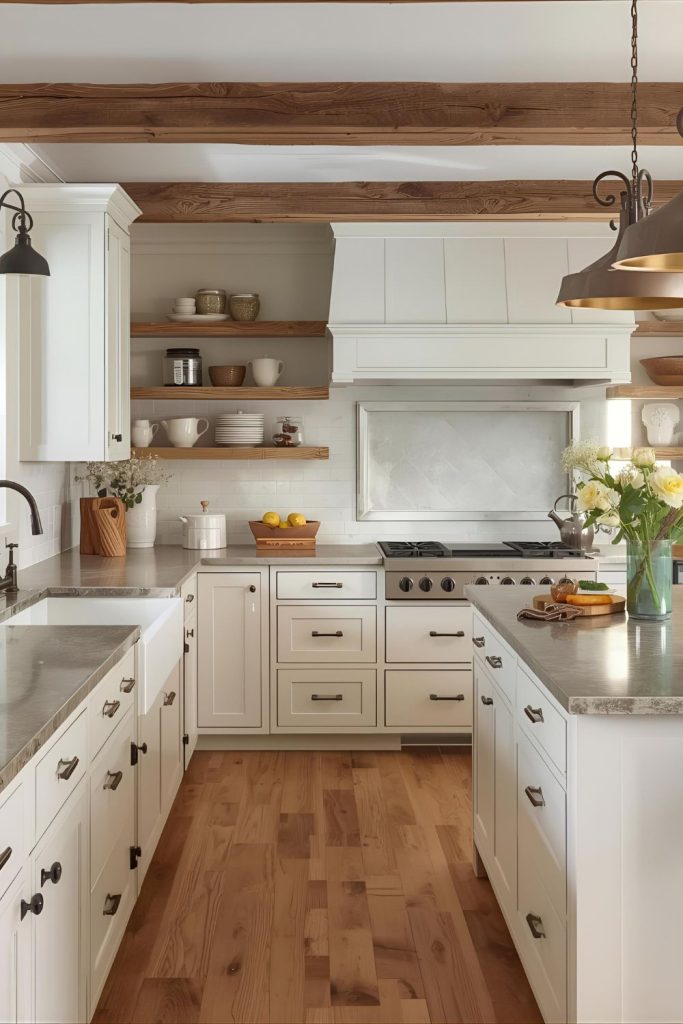
16. Creating high contrast drama through sleek black cabinetry pairings
Black cabinets make a strong statement while still looking polished. They add depth and confidence to the kitchen, especially when paired with pale counters or white walls. Homeowners exploring kitchen cabinet color ideas often consider black when they want drama without loud colors. Black works well in kitchens with lots of light because it anchors the space instead of making it feel smaller. Gold or silver hardware stands out nicely against the dark surface. If you want cabinets that feel modern and mature, black can be the perfect balance of bold and stylish.

17. Using light pastel tones to widen compact kitchen layouts
Pastel tones such as pale blue, soft blush, or light mint can make a small kitchen feel wider and more airy. These shades work well in older homes where layout changes may not be possible. Light pastel kitchen cabinet color ideas are useful because they add personality without weighing the room down. They also reflect soft light, creating a pleasant glow that enlarges the space visually. Pairing pastels with simple counters and minimal hardware gives the room a gentle presence. This choice suits homeowners who want color without strong saturation.
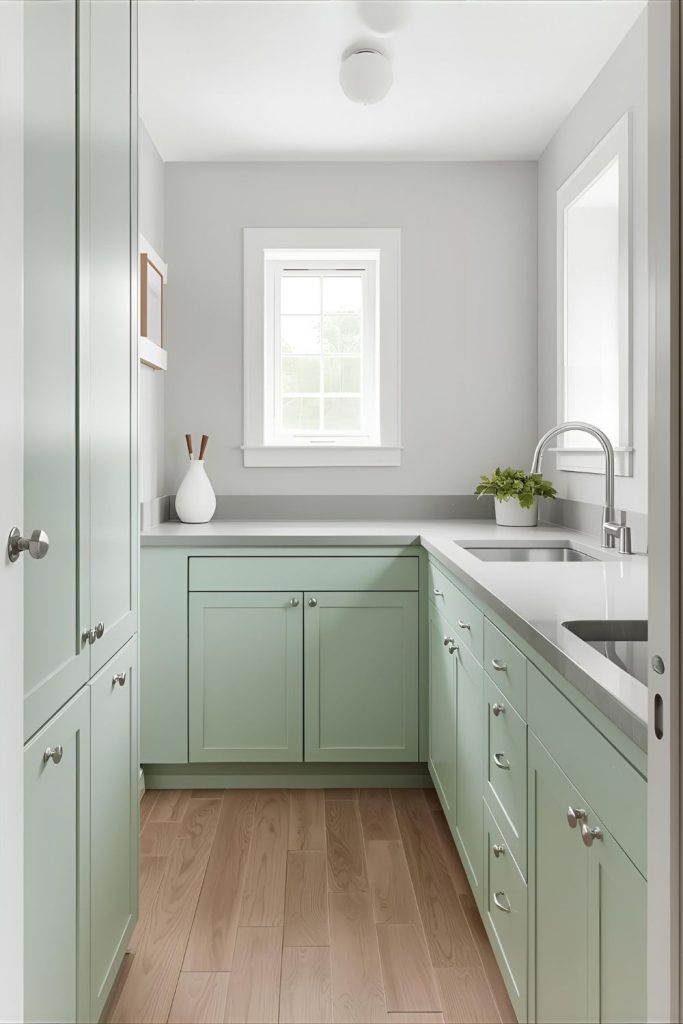
18. Building warmth through earthy brown cabinet inspiration
Earthy brown cabinets bring a comfortable, grounded feel to the kitchen. Unlike darker espresso tones, earthy browns carry soft warmth that works with beige, cream or stone counters. Homeowners reviewing kitchen cabinet color ideas often choose brown shades when they want something natural but not too rustic. These colors pair well with warm lighting and tend to hide smudges better than pale colors. Brown cabinets also match with green or clay toned accents, helping the kitchen feel steady and welcoming.
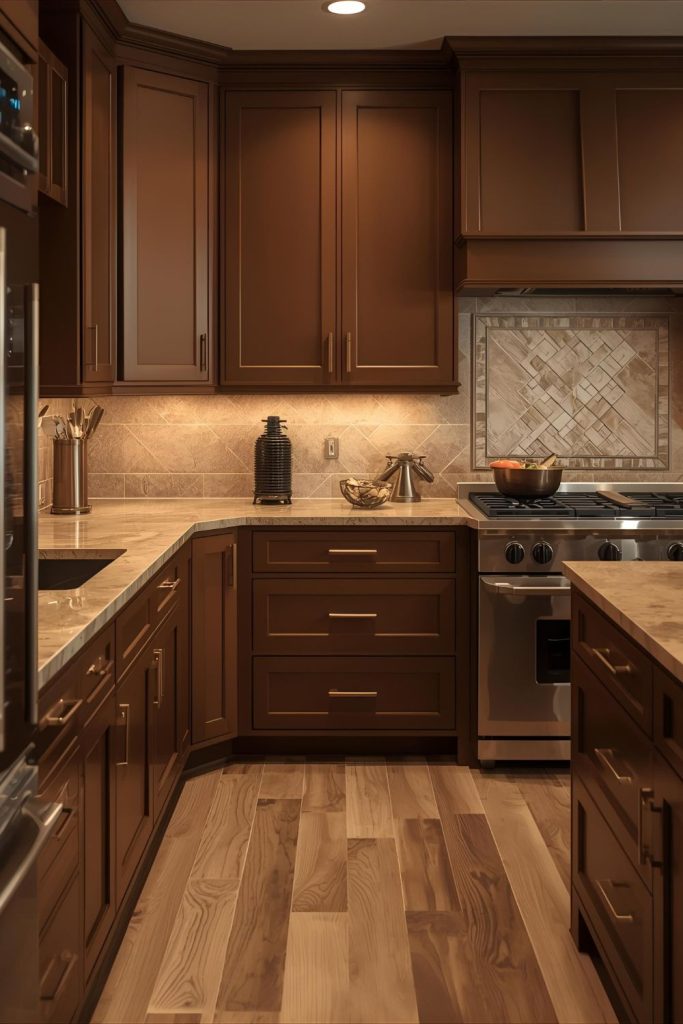
19. Using blue influenced palettes for a serene spa like kitchen mood
Blue toned cabinets can make the kitchen feel calming, similar to a spa environment. Shades like mist blue, slate blue or cloud blue soften the room and help reduce visual noise. When searching through kitchen cabinet color ideas, many people choose blue because it pairs well with white counters and brushed nickel hardware. Blue cabinets create a cooling effect, ideal for warm climates or kitchens with heavy sunlight. This color direction works well if you want a relaxing kitchen without using neutral tones alone.
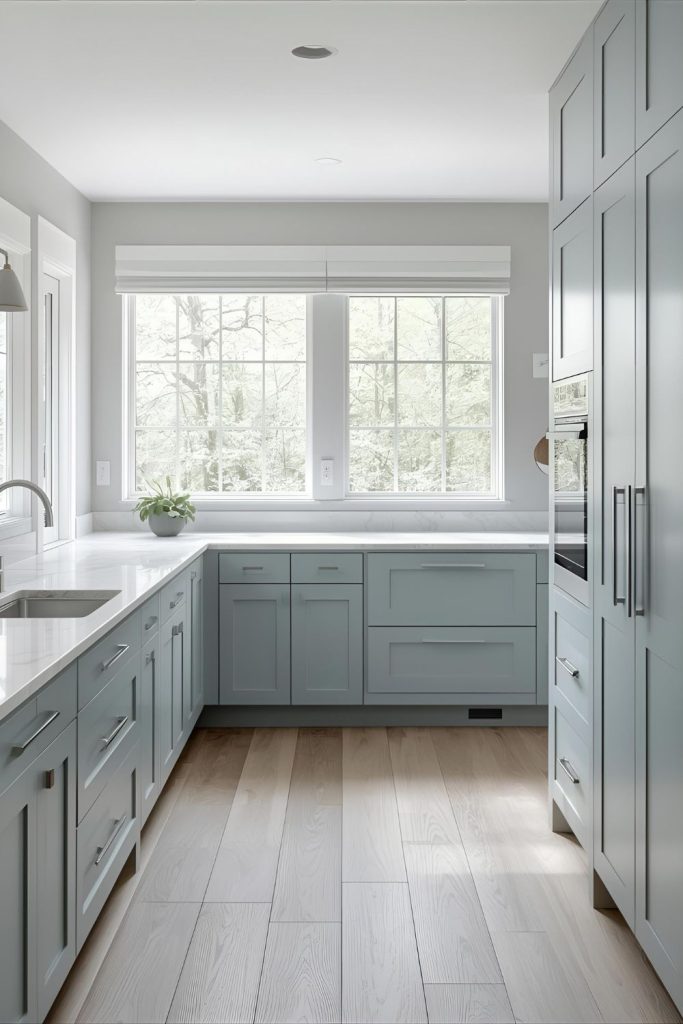
20. Clean modern cabinet hues paired with soft metallic accents
Modern kitchens often rely on clean, smooth cabinet colors such as soft gray, warm white or muted charcoal. These tones feel simple but polished. When adding metallic touches through hardware or lighting, the room takes on a balanced and fresh look. Homeowners examining kitchen cabinet color ideas often like this combination because it stays stylish without feeling trendy. The metallic accents bring a bit of sparkle without overpowering the cabinets. This style works nicely with quartz counters and slab backsplashes for a simple but finished appearance.
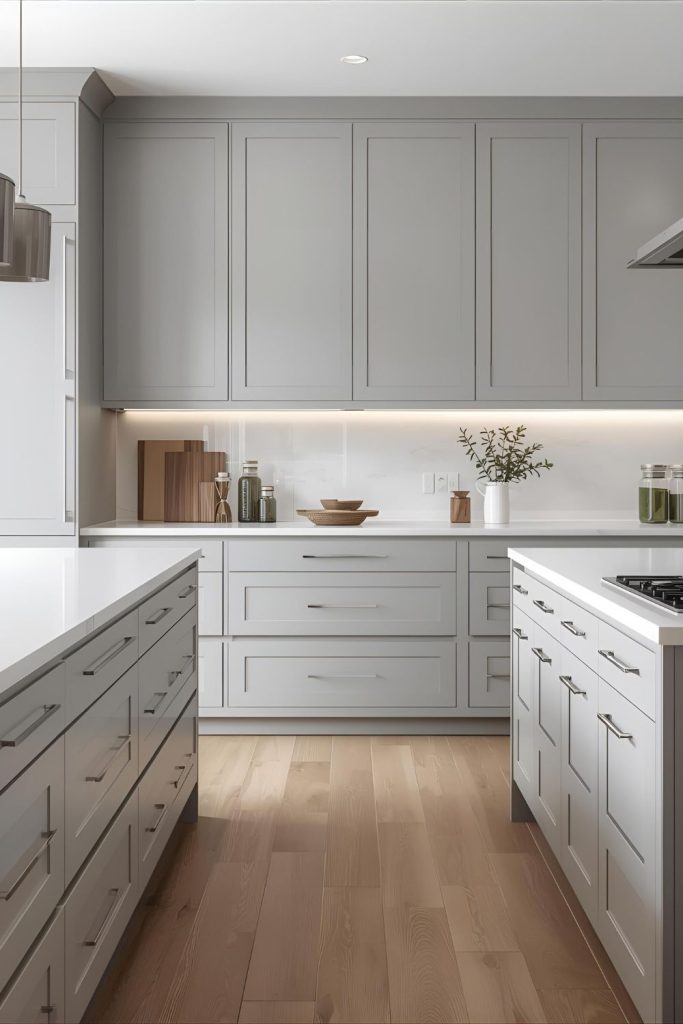
21. Adding rustic textures for a more timeworn cabinet look
Rustic textures like wire brushed wood or soft distressed finishes can give the kitchen a timeworn, familiar feeling. These textures blend well with cabinet colors that sit in the warmer family, including sandy beige, soft cream or dusty brown. Many kitchen cabinet color ideas in rustic styles use subtle aging marks or matte finishes to soften the appearance. This approach fits both modern and older homes because it brings personality into the room. Rustic styling works well with iron hardware and warm toned flooring, giving the kitchen a relaxed presence.
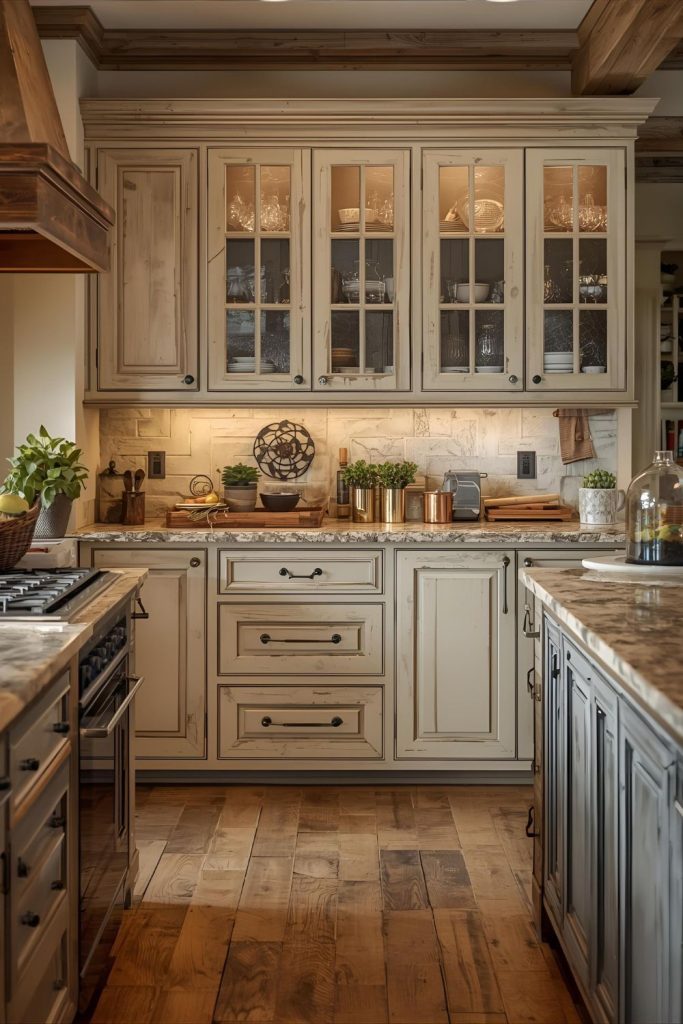
22. Trying gray infused palettes for a calm and balanced kitchen remodel
Gray infused palettes continue to be popular because they create a balanced and steady kitchen environment. There are grays with warm undertones, cool undertones and even faint green or blue hints. Homeowners browsing kitchen cabinet color ideas often choose gray when they want flexibility and low visual noise. Gray cabinets pair easily with stainless appliances, black hardware and light floors. They also hide dust more than darker colors. This color direction suits remodels where the goal is calmness and long lasting appeal.
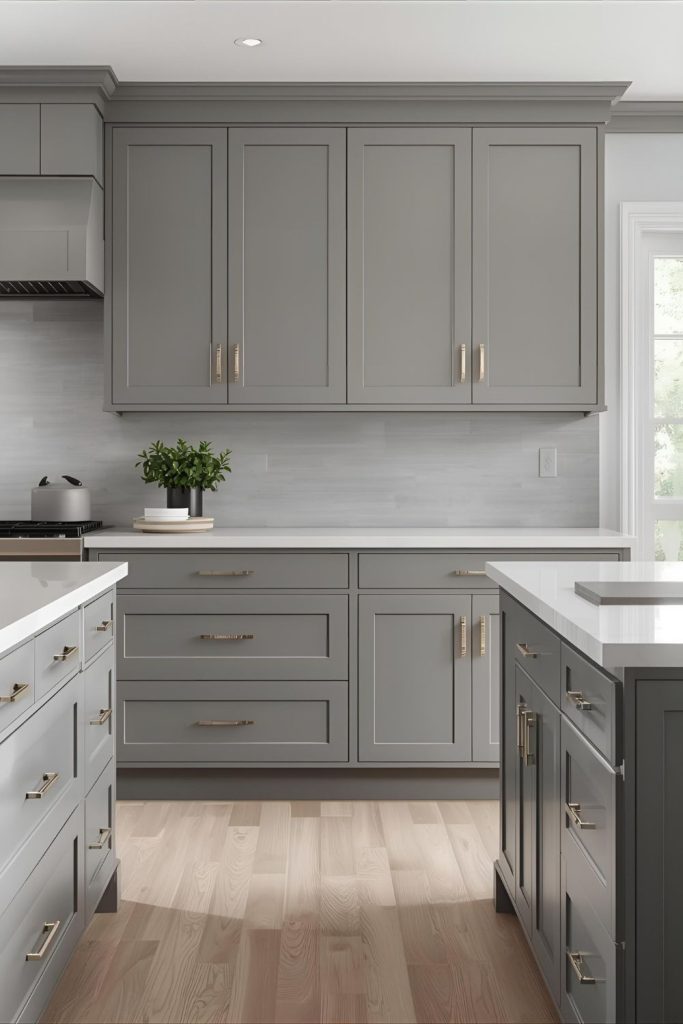
23. Coordinating soft oak cabinets with contemporary color ideas
Soft oak cabinets work well with modern styling because the grain is subtle and the color tone is warm. Oak pairs well with white, pale gray or muted green accents. Many kitchen cabinet color ideas involving oak focus on letting the wood grain show while keeping the room fresh with lighter colors. If your kitchen has open floor space or big windows, oak cabinets bring warmth without overpowering the room. This style matches nicely with simple hardware and stone counters.
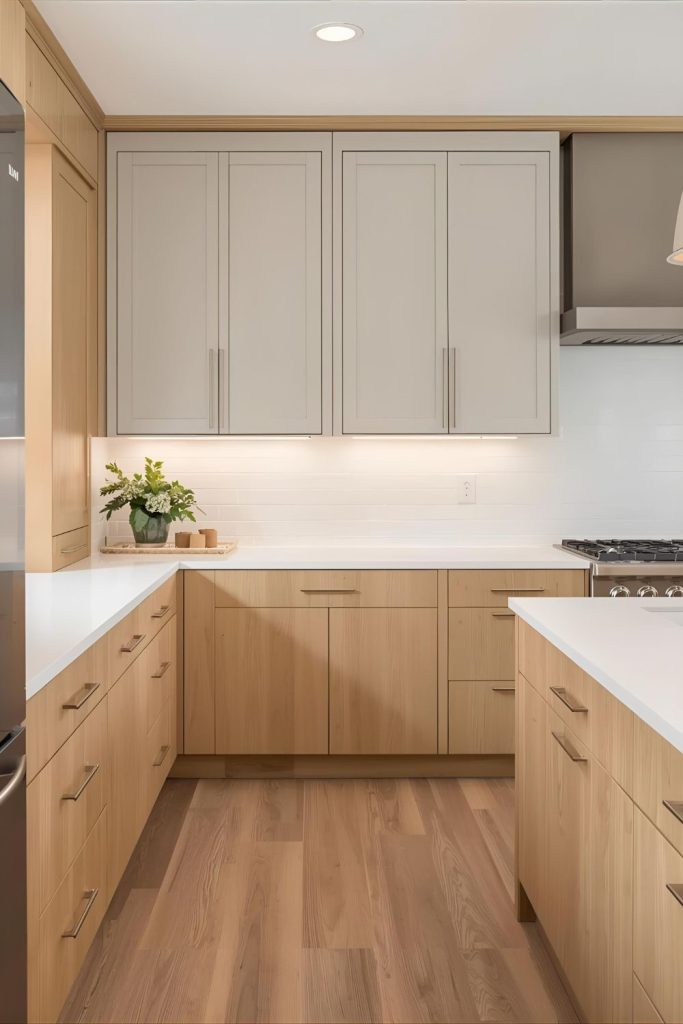
24. Reviving old kitchens with vintage color blocking
Vintage inspired color blocking uses two or more cabinet shades to create a lively, nostalgic feel. This approach works especially well for older kitchens that need personality without a full layout change. Popular kitchen cabinet color ideas for vintage blocking include soft yellow with cream, pale green with tan, or even two blues of different strengths. Color blocking brings playfulness while still staying practical. It gives homeowners freedom to refresh their kitchen without leaning on bold modern colors.
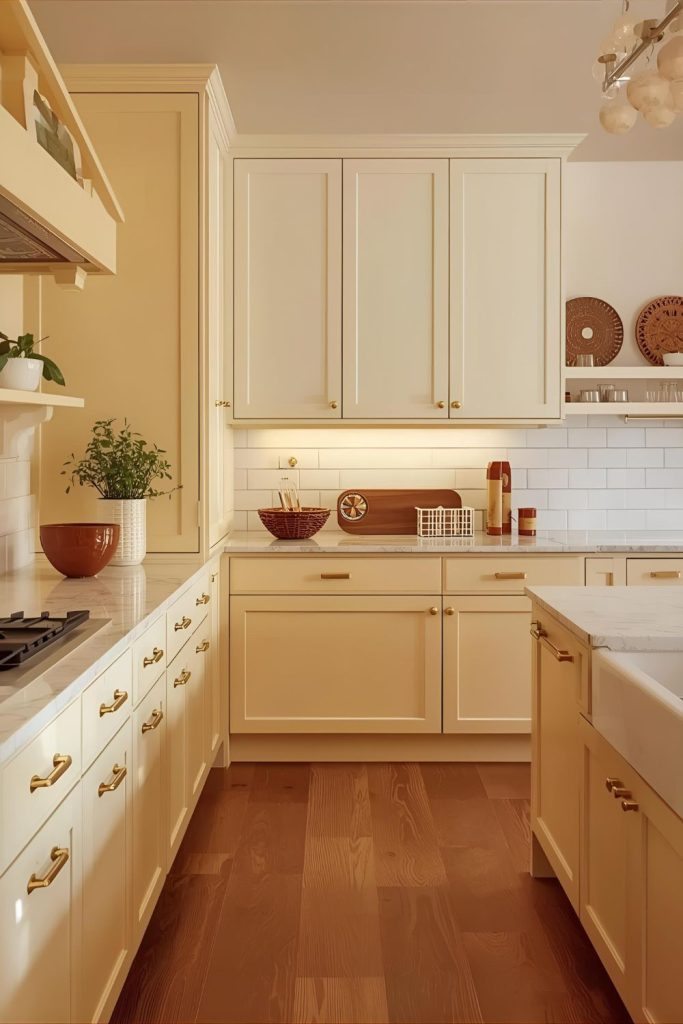
25. Bringing energy with subtle yellow touches in the cabinetry
Yellow touches in cabinets can make the kitchen feel cheerful without becoming overwhelming. Pale mustard, soft butter tones or warm straw shades can brighten a room naturally. These kitchen cabinet color ideas work especially well in homes with cooler lighting, as yellow brings warmth back into the space. Yellow pairs well with white counters, light wood floors and brushed nickel hardware. If you want an uplifting kitchen that doesn’t rely on primary colors, soft yellow offers a good middle ground.
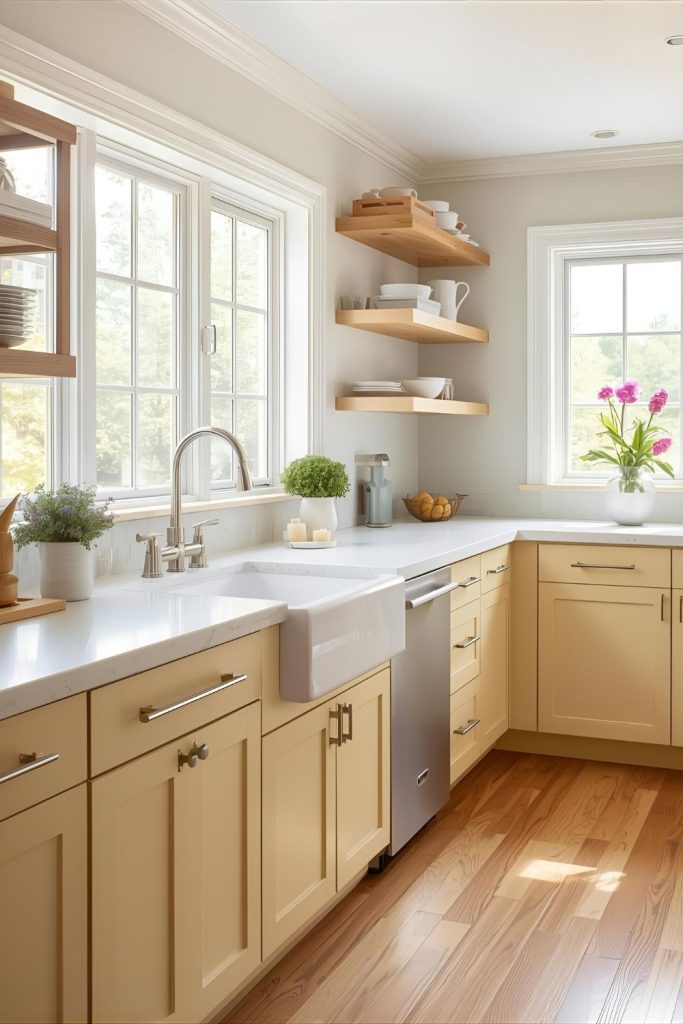
26. Cabinet colors that blend smoothly with granite surfaces
Granite has natural movement, so cabinet colors should support rather than fight its pattern. Softer warm grays, creamy taupes and subtle greens often appear in kitchen cabinet color ideas meant for granite. These shades echo the speckles and veins within the stone. Granite with gold flecks pairs nicely with warm toned cabinets, while cooler granite works better with muted blues or pale gray. When the colors match well, the room feels connected instead of busy.
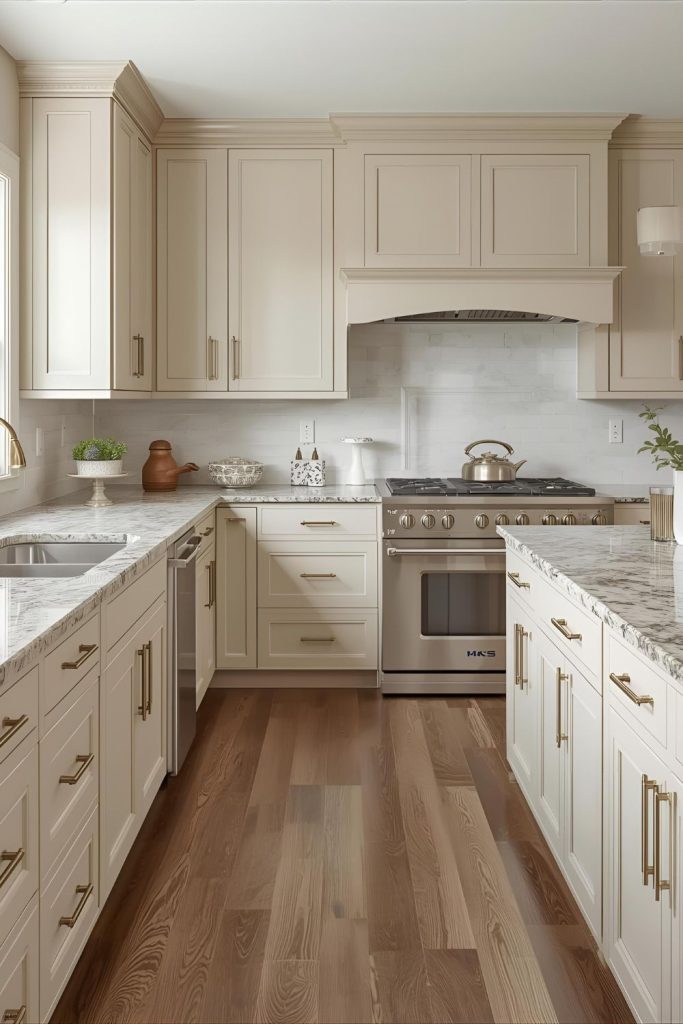
27. Pairing marble counters with complementary cabinet shades
Marble counters tend to have bright veins that draw the eye. Cabinet colors should complement those patterns instead of competing. Popular kitchen cabinet color ideas for marble include soft white, pale gray and quiet blues. These colors highlight the stone’s lines without overwhelming the room. Warm marble pairs well with cream or taupe cabinets. Marble kitchens often feel elegant, so softer tones keep the design steady and clean.

28. Achieving easy balance with neutral toned cabinetry
Neutral colored cabinets stay popular because they work in almost every style. Shades like almond, soft beige or warm cream appear often in kitchen cabinet color ideas aimed at long lasting appeal. Neutrals pair well with both warm and cool surfaces, making them a safe choice for remodels where you’re keeping certain elements like flooring or appliances. Neutral cabinets also offer flexibility with hardware changes over time.
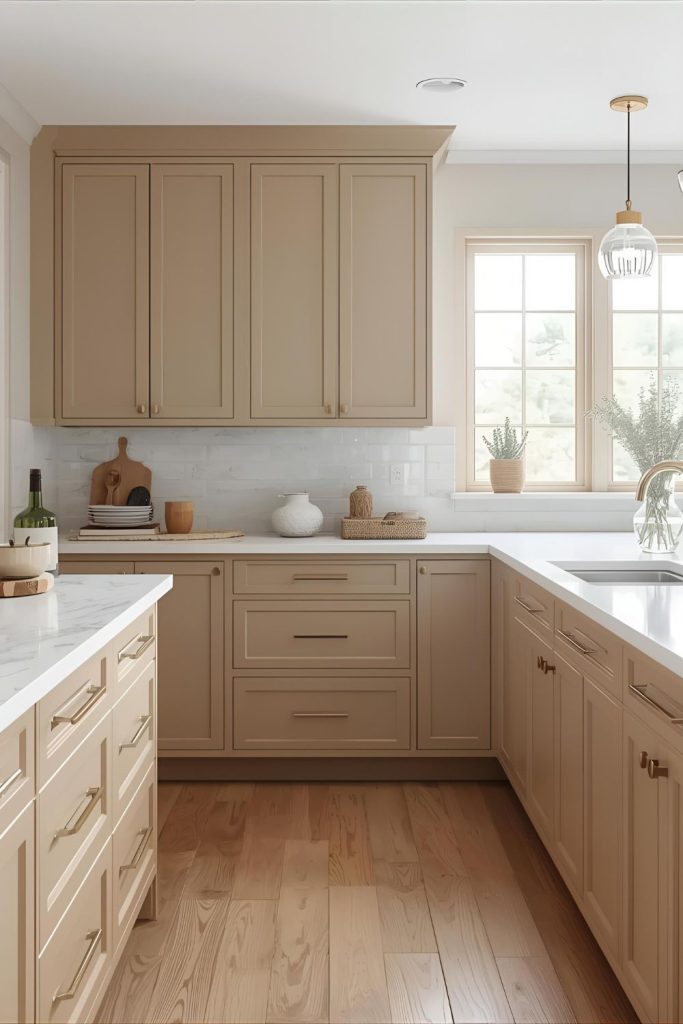
29. Making a bold island shade the main feature
Using one bold color on the island can bring personality to the kitchen without painting every cabinet. Many homeowners turn to kitchen cabinet color ideas that highlight the island with shades like navy, hunter green or dark burgundy. This allows the rest of the cabinets to stay pale while the island adds interest. The contrast draws the eye toward the center of the room, making the kitchen feel more structured.
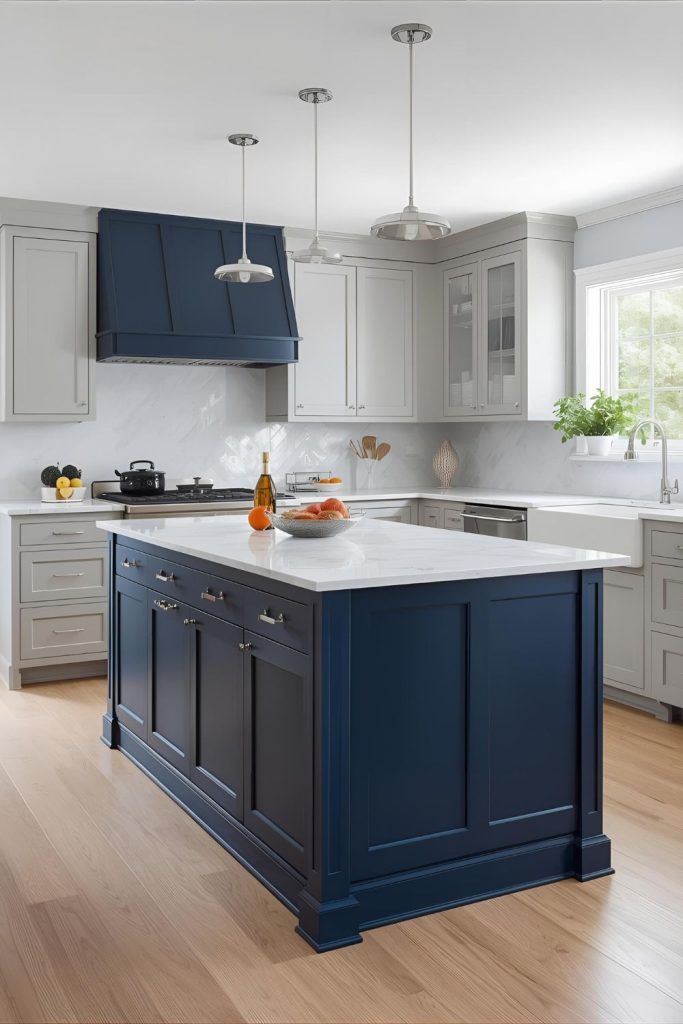
30. Coordinating cabinet colors with popular quartz countertops
Quartz counters come in clean patterns, so cabinet colors should connect with the faint tones within the stone. Many kitchen cabinet color ideas for quartz suggest warm white, soft gray or clay toned cabinets. These colors mirror the natural specks or faint veining found in quartz. Quartz is known for its clean look, so soft cabinet shades keep the kitchen feeling organized and smooth.

